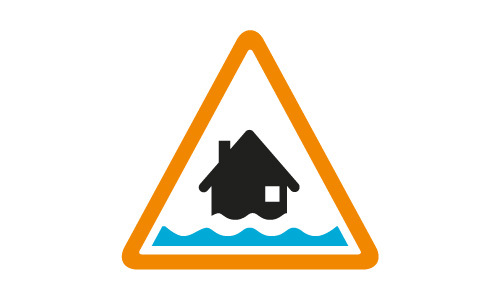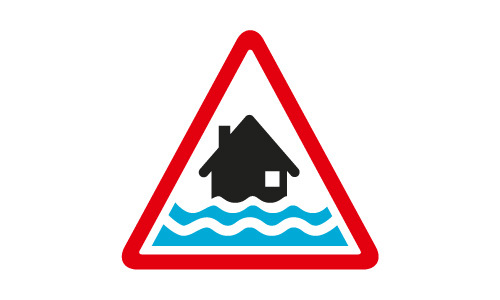Flooding guide for regulated sites
Flooding is the most common and widespread natural disaster in the UK and in Scotland, 1 in 13 non-residential properties are at risk. Flooding can’t be prevented entirely but being prepared and understanding the flood risk for your location can minimise the impact it could have on your business and employees.
Flooding can increase the likelihood of a major accident or pollution occurring and lead to severe environmental consequences. Flooding can also impact on roads and transport networks meaning employees, deliveries and collection services might face difficulties reaching you.
This guide will help you be prepared, be resilient and be aware.
Be prepared
Is my site at risk of flooding?
It is quick and easy to find out if you’re at risk:
- Check the Scottish Environment Protection Agency (SEPA) flood map to find out if your site’s postcode and footprint is at risk of flooding from rivers, the sea or surface water.
- Consider the risk of flooding from other sources such as overloaded drainage systems and from rising groundwater. Your local authority and Scottish Water may be able to provide advice on flooding from public sewers.
- View prepare for flooding for information and resources on flooding that can help you and your employees.
Know your site
- Understand how flood levels could affect your site to be better prepared to take action to limit the potential impacts of flooding.
- Obtain a topographical survey of your site and the neighbouring land. Site levels should be provided as Above Ordnance Datum (AOD) and cross-referenced to Chart Datum (Local) and Tide Tables where appropriate. You then need to relate site levels to predicted flood levels in your area.
SEPA may be able to provide more detailed information on flood risk for your site by contacting us. Depending on your location, this might include information on:
- Flood history.
- Likely flooding scenarios and predictions of flood levels where we hold this.
Where more detailed consideration of flood risk is required SEPA has published guidance on undertaking flood risk assessments.
Local authorities are responsible for the planning, construction and maintenance of flood defences in Scotland. If you would like to know what flood defences there are in your local area, contact your local authority directly.
Prepare a flood plan
Even if there are flood defences in your area, they can be overtopped by severe flooding and there is always risk that flood mitigation products can fail.
By preparing for flooding, you can reduce the potential for financial losses, damage to property and business disruption while ensuring that your employees and customers are not put at unnecessary risk.
Include information within your health and safety policy on how to prepare for a flood and include a flood plan in your contingency plans for emergencies.
Things to consider when drawing up your flood plan:
- The risks of flooding on specific areas of plant and operations. Completing a Flood Hazard and Operability (HAZOP) study could be appropriate under the Control of Major Accidents and Hazards regulations (COMAH).
- The time needed to safely shut down operations and move employees, materials and stock.
- The impact of flood water on plant and equipment, the loss of utilities on a short and long term basis and the loss of safety critical equipment and other components.
- The ability to revert to manual operations, taking into account hardware, operating procedures, competence and training.
Things to include in your flood plan:
- An employee contact list and a list of other important contacts including Floodline, suppliers etc.
- A description or map showing key locations, protective materials and service shut off points.
- Trigger points for specific actions and an allocation of tasks to individuals trained for the role.
- Flooding information including weather predictions and river and sea level information.
- Post flooding activities, including removal of water, integrity checks and inventory checks to identify loss of any polluting or hazardous materials.
Be resilient
Take action now to help protect your operation from flooding. You should assess all functions of your site and consider specific flooding hazards and mitigation actions. The information in this guide is not exhaustive and is for guidance only.
Infrastructure and utilities
These measures can help to stop flood water reaching your site or reduce its impact on vulnerable operations. You may need permission from your local council or SEPA to implement some of these measures:
- Drainage systems with excess capacity and penstocks.
- Sustainable drainage techniques such as retention ponds and soakaways.
- Ground and platform raising or diversion channels.
- Permanent or temporary flood defences.
- Effective maintenance of drainage and flood management systems.
Make sure that electricity (including on-site transformers and substations), gas, steam, heating, cooling and water supply systems are above predicted flood levels, are flood resilient or can be safely isolated or switched off before flooding. The loss of utilities may be for an extended period, so consider the installation of backup systems for critical equipment.
Buildings and storage
Where stock, polluting/hazardous substances and waste have to be stored in areas at risk of flooding, the following actions should be taken. Particular consideration should be given to hazardous substances which react in the presence of water.
Warehouses
Vulnerable assets and stock should be moved above predicted flood levels. Flood defence products e.g. flood boards and demountable doorway barriers could be installed. Go online to find products suitable for your needs; Blue Pages is a directory of flood products and suppliers however it is not an exhaustive list.
Bulk storage and process tanks
Floodwater can cause tanks to float, resulting in the disconnection of pipelines and loss of the contents stored. Tanks can be raised above predicted flood water levels as long as this doesn’t compromise the tank integrity and safe operation. Alternatively, make sure that tank anchor points are able to withstand tank buoyancy. Underground tanks may be particularly vulnerable to flooding. When flooding is predicted, pipework should be emptied, valves closed and delivery pumps turned off.
Drums and intermediate bulk containers (IBCs)
Drums and similar vessels can float in flood water resulting in loss of containment or downstream blockages and potentially complicated off-site recovery. Portable containers should either be permanently elevated above predicted flood levels or moved and secured if a flood is predicted. Secure fencing and gates at site boundaries should be used to prevent small containers floating off-site.
Waste
Waste material and associated containers are at risk of floating away. Soluble material should not be stored where it may come into contact with flood water. A dedicated flood resistant store may be appropriate to minimise these risks.
Radioactive substances
Radioactive substances should not be stored in the flood plain. If there is no alternative, position and manage these to ensure that they cannot come into contact with flood water. Users of mobile sources of radioactive substances should consider flood risk when sources are stored and used away from their home base.
Effluent treatment and oil separation systems
Effluent treatment and oil separation systems are likely to contain quantities of untreated effluent, retained sludge or oil at risk of being lost if the system is flooded. These systems are likely to be at greatest risk as they are often positioned at the lowest point of a site.You should assess the need to empty oil separators, treatment plants, storage tanks and effluent pipe work before they’re flooded. Make sure that systems that have been subjected to flooding are working correctly before using them again.
Systems and security
Consider the wider impact of flooding on business continuity, the resilience to flooding of business critical information, IT systems and impacts on employees.
Safety critical control systems
Consider the location of safety critical plant e.g. control rooms, process control and instrumentation systems and emission abatement plant. Where this equipment could be inundated by water, assess its flood resilience and its vulnerability to damage by floating objects. Where equipment can’t be moved above predicted flood levels and its resilience can’t be assured, hazardous activities should be safely halted when flooding is predicted.
Information security
Relevant information on the inventory of polluting material and waste, or the inventory of radioactive sources and waste, should be kept and managed so that it is not at risk of damage or loss during flood events.
Emergency response
Flooding that affects an industrial site or its surrounding region is also likely to disrupt emergency response by:
- Delayed or diminished attendance by off-site emergency services.
- Disruption to normal response measures such as fire-fighting or pollution control.
- Delayed evacuation of employees and local residents.
Use SEPA’s flood maps to assess whether access and evacuation routes for your sites are likely to be affected by flooding. Contact your local authority emergency planners to discuss how they have prepared for flooding of your site. Due to the impact of flooding on emergency plans it may be necessary to suspend hazardous activities when flooding is predicted.
Be aware
Floodline provides live flooding information and advice for Scotland 24 hours a day, 7 days a week.
Floodline issues three types of message:
- Flood alert
- Flood warning
- Severe flood warning

Flood alert

Flood warning

Severe flood warning
Familiarising yourself with the flood symbols and what they mean will help you take action at the right time.
Register by phone or online to receive free advance notice of flooding direct to your landline or mobile phone:
- Sign up online
- 0345 988 1188
- Remember to register all vulnerable sites, not just your head office.
View live flood updates for Scotland.
This guidance has been developed as part of a programme of work undertaken by CDOIF. A separate guide is also available for sites regulated under EPR and COMAH by the Environment Agency and Natural Resources Wales.
CDOIF (Chemicals and Downstream Oil Industries Forum) is a collaborative venture formed to agree strategic areas for joint industry/trade union/regulator action aimed at delivering health, safety and environmental improvements with cross-sector benefit
